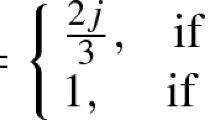Abstract
We show that Hermite’s approximations to values of the exponential function at given algebraic numbers are nearly optimal when considered from an adelic perspective. We achieve this by taking into account the ratio of these values whenever they make sense in the various completions (Archimedean or p-adic) of a number field containing these algebraic numbers.

Similar content being viewed by others
References
Ayarai, S., Dubuc, S.: La formule de Cauchy sur la longueur d’une courbe. Can. Math. Bull. 40, 3–9 (1997)
Baker, A.: On some Diophantine inequalities involving the exponential function. Can. J. Math. 17, 616–626 (1965)
Baker, A.: Transcendental Number Theory. Cambridge University Press, London (1975)
Bombieri, E., Vaaler, J.: On Siegel’s lemma. Invent. Math. 73, 11–32 (1983)
Brownawell, W.D.: Some remarks on semi-resultants. In: A. Baker, D.W. Masser (eds.) Transcendence Theory: Advances and Applications, chap 14. Academic Press, New York (1977)
Bundschuh, P.: Irrationalitätsmaße für \(e^a\), \(a\ne 0\), rational oder Liouville-Zahl. Math. Ann. 192, 229–242 (1971)
Chudnovsky, G.V.: Some analytic methods in the theory of transcendental numbers. In: Mathematical Surveys Monographs, vol. 19, chap 1. American Mathematical Society, Providence, R.I. (1984)
Forster, O.: Lectures on Riemann Surfaces. Graduate Texts in Mathematics, vol. 81. Springer, New York (1981)
Hermite, Ch.: Sur la fonction exponentielle. C. R. Acad. Sci., Paris 77, 18–24, 74–79, 226–233, 285–293 (1873). Œuvres de Charles Hermite, vol. III, Cambridge University Press, 2009, pp. 150–181; also available on the web site http://www.bibnum.education.fr
Mahler, K.: Zur approximation der exponentialfunktion und des logarithmus. Teil I. J. Reine Angew. Math. 166, 118–136 (1932)
Mahler, K.: Lectures on transcendental numbers. In: Lecture Notes in Mathematics, vol. 546. Springer, Berlin (1976)
Mcfeat, R.B.: Geometry of numbers in Adele spaces. Dissert. Math. Rozprawy Mat. 88, 1–49 (1971)
Perron, O.: Die Lehre von den Kettenbrüchen. Chelsea, New York (1950) (reprint of the 2nd edn, 1929)
Robba, P.: Lemmes de Schwarz et lemmes d’approximations \(p\)-adiques en plusieurs variables. Invent. Math. 48, 245–277 (1978)
Schmidt, W.M.: Diophantine approximation. In: Lecture Note in Mathematics, vol. 785. Springer, New York (1980)
Thunder, J.L.: Remarks on adelic geometry of numbers. In: Number Theory for the millennium, vol. III (Urbana, IL, 2000), pp. 253–259. A K Peters (2002)
Waldschmidt, M.: An introduction to irrationality and transcendence methods. In: Lecture 2, 2008 Arizona Winter School. https://webusers.imj-prg.fr/~michel.waldschmidt/articles/pdf/AWSLecture2.pdf
Weierstrass, K.: Zu Lindemann’s Abhandlung “Über die Ludolph’sche Zahl”. Berl. Ber. 1067–1086 (1885)
Acknowledgements
I warmly thank Michel Waldschmidt for numerous exchanges on these questions. In particular, his course notes [17] were a source of inspiration. I also thank the referees for helpful comments.
Author information
Authors and Affiliations
Corresponding author
Additional information
Communicated by Kannan Soundararajan.
Publisher's Note
Springer Nature remains neutral with regard to jurisdictional claims in published maps and institutional affiliations.
Research partially supported by NSERC (discovery grant).
Appendix A. Recurrence relations
Appendix A. Recurrence relations
The notation being as in Sect. 2.2 we extend the definition of \(f_{\mathbf {n}}(z)\), \(P_{\mathbf {n}}(z)\) and \(a_{\mathbf {n}}\) to any s-tuple \({\mathbf {n}}\in {\mathbb {Z}}^s\) by setting
For each \({\mathbf {n}}\in {\mathbb {N}}_+^s\), we denote by \(A_{\mathbf {n}}\) the matrix whose \(\ell \)th row is \({\mathbf {a}}_{{\mathbf {n}}-{\mathbf {e}}_\ell }\) for \(\ell =1,\dots ,s\). In [9, Sect. IX–X], Hermite provides a recurrence formula linking \(A_{{\mathbf {n}}+{\mathbf {1}}}\) to \(A_{\mathbf {n}}\) where \({\mathbf {1}}=(1,\dots ,1)\). Here we give more general recurrence relations based on the same principle. The formula (A.1) below is due to Hermite [9, Sect. IX, p. 230] when \({\mathbf {n}}\in {\mathbb {N}}_+^s\).
Proposition A.1
Let \({\mathbf {n}}=(n_1,\dots ,n_s)\in {\mathbb {N}}^s\). We have
Moreover, if \(k,\ell \in \{1,\dots ,s\}\) with \(n_k\ge 1\), we also have
Proof
Leibniz formula for the derivative of a product gives
Taking the sum of all derivatives on both sides of this equality, we obtain
and (A.1) follows. The formula (A.2) is trivial if \(k=\ell \). Suppose that \(k\ne \ell \) and \(n_k\ge 1\) so that \({\mathbf {n}}-{\mathbf {e}}_k\in {\mathbb {N}}^s\). Then we find
Taking again the sum of the derivatives, this yields
and (A.2) follows. \(\square \)
Corollary A.2
Let \({\mathbf {n}}=(n_1,\dots ,n_s)\in {\mathbb {N}}_+^s\) and \(\ell \in \{1,\dots ,s\}\). Then we have
where
Proof
As the entries of \({\mathbf {n}}\) are positive, the polynomial \(f_{\mathbf {n}}\) vanishes at all points \(\alpha _1,\dots ,\alpha _s\) and the formulas of Proposition A.1 yield
When \(s=2\), this provides a quick way of computing the matrices \(A_{n,n}\).
Corollary A.3
Suppose that \(s=2\), \(\alpha _1=0\) and \(\alpha _2=\alpha \in K{\setminus }\{0\}\). Then, for each \(n\in {\mathbb {N}}_+\), we have
where
Proof
We find that \(P_{0,1}(z)=z+1-\alpha \) and \(P_{1,0}(z)=z+1\), thus \(A_{1,1}=C_1\). In general, for an integer \(n\ge 1\), the formulas of the preceding corollary give
and the conclusion follows by induction on n. \(\square \)
Rights and permissions
About this article
Cite this article
Roy, D. Simultaneous approximation to values of the exponential function over the adeles. Math. Ann. 377, 1057–1093 (2020). https://doi.org/10.1007/s00208-020-02005-5
Received:
Revised:
Published:
Issue Date:
DOI: https://doi.org/10.1007/s00208-020-02005-5




